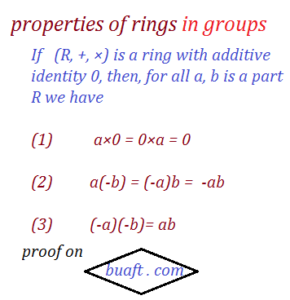Properties of rings in groups, let (R, +, ×) be a ring. Since (R, +) is a group, all the group properties for addition hold in R. (real number)

The unique identity of the additive group is called the zero element of the ring, and we denote it by 0. Thus, a + 0 = 0 + a = a for every a ∈ R (a. is a part of real number).
We denote the unique additive inverse of an element a by – a and write as a + (-a) = a -a = 0 and a + (-b)= a – b. We note that the properties of the additive inverse and the zero element give us the cancellation law.
If a + b = a + c, b = c, a unique solution x = b – a, of the equation a + x = b and the rule – (- a) = a, if n ∈ Z and n > 0.
Furthermore,
we define n×a = a + a + a +……..a(n term).
If n< 0 we define n.a = (-a)+(-a)+(-a)…….(-a)(n terms). And if n = 0,
we define 0a = 0, Where 0 ∈ Z on the left side of the equation and 0 ∈ R on the right side.
The reader may note that n.a, is not to be considered As a product of n and a. in the ring, for the integer+ n may not be in the ring at all.
The equation 0×a = 0 holds also 0 ∈ R on both sides.
Properties of rings in groups:
EXAMPLE BY THEOREM:
If (R, +, ×) is a ring with additive identity 0, then, for all a, b ∈ R we have
(1) a×0 = 0×a = 0
(2) a(-b) = (-a)b = -ab
(3) (-a)(-b)= ab
PROOF:
(1) a 0 = a(0 +0) = a 0 + a 0
Hence, 0 + a 0 =a 0 + a 0
by the cancellation law for the additive group (R, +),
we have
0 = a 0
likewise,
0 a = (0 + 0)a = 0 a + 0 a implies 0 a = 0
(2) a(-b) = (-a)b = -a b
proof:
By definition, – (ab) is the element which added to ab gives 0. Thus, in order to show
a(-b) = -(ab), we must show a(-b) +ab = 0 by the left distribution Law
a (-b) +ab = a (-b+ b) = a 0 = 0
similarly, (-a) b+ab = (-a + a) b = ob= 0
The result follows from the above equation.
(3) proof:
Using operation adopted in 2
(-a)(-b)= -(a(-b)) = -(-(ab)= ab
RELATED POST:
- composite and prime number factor
- ascending and descending order number
- Mantissa of logarithm of real number
- linear inequalities in ordered pair